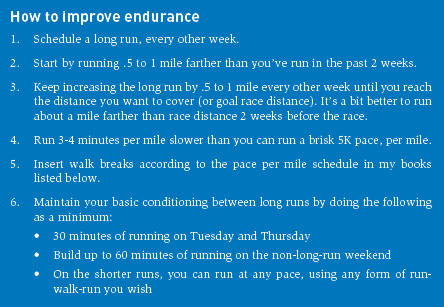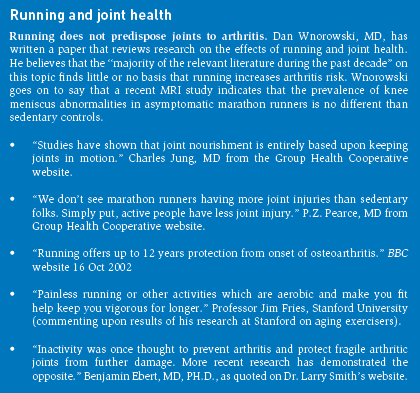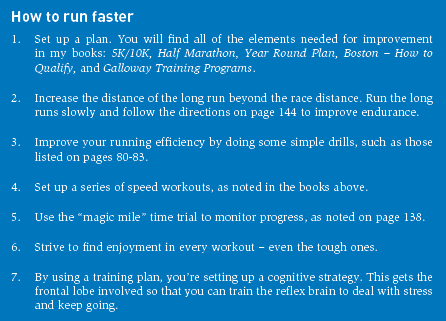

| 49 | I run so that I can glide |
By using efficient running form, you can feel smoother on every run. The secret is to reduce the running motion to a simple and gentle movement pattern. By focusing on the principles below and doing a few energizing drills, you can teach yourself to run easier and faster.
Running is a natural motion for the human body. As you run regularly, your right brain subconsciously searches for more efficient patterns. Studies show that runners get smoother as they continue to run regularly.
Trying to mimic someone or force a certain running technique on oneself will usually result in aches, pains, and/or injuries. Many of these problems surface when runners try something they read in an article or imitate someone faster than they are. The best form for you is that which follows your natural range of motion.
Here are the general principles of efficient running form:
| • | Feet low to the ground |
| • | Relatively short range of motion and short stride |
| • | Light touch of the foot |
| • | Generally upright body posture |
If one naturally leans forward, then this is fine. Be aware that a forward lean can put stress on the back and/or the neck.
When the stride is naturally short enough and the feet are low to the ground, the ankle does most of the work. This will make running smoother and easier, reducing the work of the calf muscle. The cadence drill below will help you adapt naturally to an efficient use of the ankle.
You can train yourself to be a better glider by doing the acceleration-glider drill listed below.

| 50 | A quicker cadence picks up my spirit |
Thousands of runners have told me that the one factor that “wakes them up” when they get bored or tired is increasing cadence or foot turnover. By using the cadence drill (CD) below, you can pick up the rhythm of your feet and brain.
There are thousands of sensors in the feet, legs, and brain that send signals to your subconscious reflex brain, activating established circuits to keep you running in a pattern that has worked before. After a year or two of regular running, most runners have adapted to an efficient range of motion and can run almost on “automatic pilot.” It is natural to reach a state of boredom when under the influence of these circuits.
The cadence drill gently jolts the sensors and forces them to adapt. This energizes the mind-body network to make other physical changes. The first boost of energy comes from this change.

A greater energy injection comes from focusing on cadence and counting. This cognitive action shifts mental activity into the frontal lobe. The repetitive circuits of the reflex brain are overridden by the conscious brain. By shifting into the frontal lobe, you can receive another energy boost.
You’ll break up the boredom by going on a mission. As you focus simply on increasing one count during each successive cadence interval, you stimulate the right brain to make the intuitive adjustments that help you run easier, lighter, and faster. By doing this for at least 4 repetitions, once or twice a week, you will format the search for efficient adaptations into the subconscious brain.
So when you are bored with an “automatic pilot” cadence, break out and increase the turnover. And when the cadence slows down at the end of a race, you will have prepared yourself to shift into a quicker turnover by doing a series of CDs.
Here’s how:

| 51 | Long runs are “health injections” |
Endurance is the top benefit of running. As the long runs surpass 3 miles, 6 miles and beyond, overall stamina in life improves as does the mental toughness to deal with adversity in other areas of life.
Many internal circuits are switched “on” when we push back our current endurance limit. Research is now showing that long runs provide significant long-term health benefits:
| • | More blood capillaries develop in the exercising muscles for better delivery of oxygen |
| • | The heart becomes more efficient |
| • | Oxygen delivery is enhanced in lungs and blood system |
| • | Mitochondria in muscle cells adapt to be better fat-burners |
| • | Bones are either strengthened or don’t tend to lose density |
| • | Lower legs develop a smoother motion |
| • | Feet adapt to regular forward motion exercise |
| • | Frontal lobe solves problems, finds resources, stays active and sharp |
| • | Mental health: Runners tend have a positive outlook and less depression |
| • | Energy circuits are activated |
| • | Joints adapt – runners have fewer orthopedic problems |
For every hour you run, you statistically extend your life by 2-3 hours.
Let’s run ourselves into better health as the years go by.


| 52 | I want to keep my joints active now and 30 years from now |
It may surprise you to know that runners tend to have better orthopedic units than non-runners as the decades go by. When I wrote my book Running Until You’re 100, I compiled the studies on this issue and could not find any showing negative effects from running.
The old saying “use it or lose it” rings true. The research continues to pile up showing that if you use your joints, muscles, tendons, etc., in a natural way, without abusing them, they will continue to adapt and stay healthy.
The body is programmed to adjust and make changes based upon what you do regularly. If you run every other day, and insert the walk breaks needed for you, the orthopedic units will tend to continue adapting.
My run-walk-run method has walk breaks programmed from the beginning of a run. This provides a rest period for the joints, etc., from the stresses of running. During this break, the body repairs and replenishes a little at a time.
During my first 20 years of running, I was injured about every 20 days. Since I started taking walk breaks, over 30 years ago, I haven’t had a single overuse running injury. I’m not alone. I hear from others about every day who were regularly injured until they started using the run-walk-run method from the beginning of the run. They have also avoided the return of what was, for many, regular periods of time off from running.
In Running Until You’re 100, I showcase a number of those who are headed toward that age group and are still running a great deal. One is Don McNelly who was 85 when I interviewed him. That year, he finished 29 marathons. Don told me that his non-running friends accused him of choosing his parents well, but that was not the case: both sedentary parents had to have hip replacements in their 70s.
OK, let’s move the joints and keep them in good working order!



| 53 | I want to run faster |
Our egos thrive on faster times. With each improvement, there is a temporary boost to the ego, often followed by motivation to train harder for even faster times. The ego thrives on improvement.
Caution: Don’t let the time goal be your primary satisfaction from running. Enjoy the endorphins, the accomplishment in completing each workout, and the joy of learning new things about running. Most of the world-class runners with whom I’ve talked about this issue have enjoyed the journey to the top more than the recognition and performances on the elite stage.
To get faster, you must run faster during some targeted workouts. The plans in the books listed below will help you develop a coordinated strategy for improvement. While there are ego frustrations along the track to faster times, you’ll learn some new things about yourself – usually more from the setbacks than the successes.
The speed workouts can improve your performance in many areas: muscle capacity, heart function, oxygen delivery, running mechanics, and the coordination of body parts and organs to keep going fast while tired.
The mental benefits may be more significant. As you tap into these enhancements, you will see yourself as one who can push on when tired and uncertain, and that you can rise up from a setback and improve. On some occasions, the attitude boost from faster runs is more powerful. As you become more capable in pushing back the physical barriers, you can receive more confidence and empowerment in your mental outlook on running and life.
Any form of speed training increases risk of injury. But if you follow the guidelines in the sidebar below, you can reduce this enhanced risk. There are also mental “injuries” that occur when you don’t manage the stress or ego. Part of the speed training process is learning how to prevent these from occurring.
Mental training can be done while you are doing speedwork. Setting up and focusing on the strategic workouts puts you in the frontal lobe. This can maintain control over the reflex brain, managing and reducing the negative attitude hormones normally produced due to stress. The three cognitive training techniques in my Mental Training book could be applied during the workouts.
Set up your speed program and enjoy the faster times as you enjoy the good times spent running.

| 54 | I want to beat my obnoxious, bragging neighbor |
In most running groups, there are usually a few runners whose aspirations exceed their accomplishments. Only a tiny percentage of these let their egos get the best of them and make unrealistic predictions and other claims. This makes them targets for other runners who want to show that talking doesn’t get the muscles, heart, and mind ready for a goal.
Most commonly the bragger targets a key community race and tells everyone how well he or she is going to run. This allows one to out-train the bragger, which usually isn’t hard to do. In my experience, these folks derive their satisfaction from impressing less-experienced runners with claims. Most that I’ve tracked don’t have an adequate scheduled training program to achieve what they project and bounce from one type of training to the next based upon the most recent popular article in the media.
There is great satisfaction in setting up a plan and staying with it to the end. Whether you beat your neighbor or not, you will learn a lot about how to train and how to race. You’ll discover some interesting things about yourself and how to push into challenges.
If all goes well, you will pass the neighbor during the last third of the race. Be sure to say “you’re doing great.” You don’t have to say, “I’m sorry that this race didn’t turn out the way you told us it would.”
After the race, you will have the option of listening to the excuses of your neighbor or simply enjoying your accomplishment in following and fulfilling a plan.
